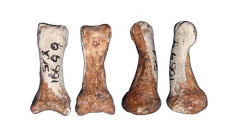

 Comptes Rendus Palevol
15 (8) - Pages 978-987
Comptes Rendus Palevol
15 (8) - Pages 978-987In order to assess the antiquity of derived human lateral (lesser) toe morphology, the SKX 16699 Early Pleistocene pedal proximal phalanx from Swartkrans (South Africa) was compared to samples of pedal phalanges attributed to Pliocene/Pleistocene australopithecines, Homo naledi and Late Pleistocene Homo. In contrast to australopith lateral phalanges, the SKX 16699 phalanx exhibits an absolutely (and probably relatively) short length, limited plantar diaphyseal curvature, proximal-to-midshaft and mid-dorsoplantar flexor sheath insertions, and a marked proximodorsal orientation of the metatarsal facet. SKX 16699 is intermediate between the australopith phalanges and later Homo ones in its modest dorsal diaphyseal curvature and mid-dorsoplantar metatarsophalangeal collateral ligament insertion areas. Its diaphyseal robustness is similar to that of Homo phalanges, but overlaps the range of later australopith ones. This combination of features and the close morphological affinities of SKX 16699 to later Homo proximal pedal phalanges suggest the emergence of a distinctly human lateral forefoot by the initial Early Pleistocene.
Paleoanthropology, Foot, Toes, Australopithecus, Paranthropus, Homo